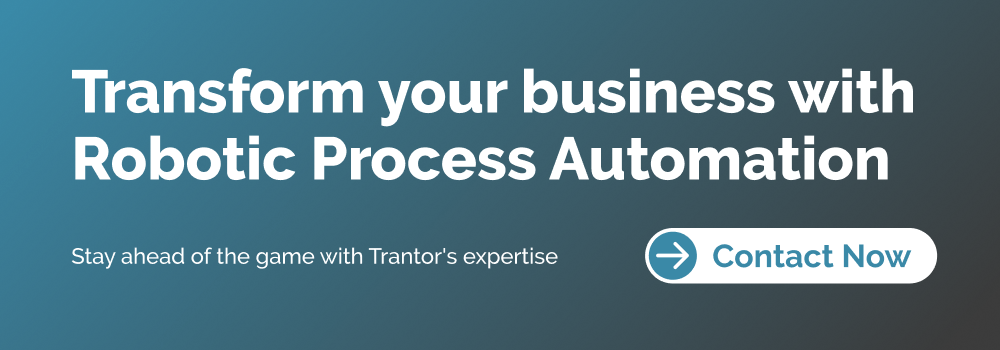CaptiveCoE™, zBlog
Building a Successful Robotic Process Automation Center of Excellence: A Roadmap
trantorindia | Updated: October 11, 2022

The robotic process automation center of excellence (RPA CoE) is becoming a prominent trend in the field of robotic process automation (RPA). As businesses increasingly adopt RPA to automate various functions, the market for RPA is projected to reach $12 billion by 2025. The implementation of RPA bots leads to significant savings in terms of money, time, and energy.
To leverage these benefits, organizations are establishing RPA CoEs to develop strategic plans, scale RPA solutions, and standardize their implementation across the entire organization.
What Precisely is a Robotic Process Automation Center of Excellence (CoE)?
RPA adoption is growing by leaps and bounds across industries. According to Grand View Study, the worldwide RPA market is predicted to expand at a CAGR of 38.2% between 2023 and 2030.
Robotic process automation, when done correctly, provides numerous benefits to the business; otherwise, it could be a costly overhead. Organizations that proceed with Implementations without good planning often fail miserably. Here is where a Robotic process automation center of excellence comes in handy.
In layman’s terms, the Robotic process automation center of excellence facilitates RPA adoption throughout the organization. It is the beating heart of a company’s RPA.
An RPA center of excellence is a unified unit designating automation opportunities, developing automation use cases, and providing stability, best practices, support, and managing automation projects.
It assists a company in achieving end-to-end automation of organizational processes by integrating people, technology, and procedures. It also assesses the success of an organization’s RPA initiatives
Why do Businesses Require an RPA Center of Excellence?
A robotic process automation CoE is an organization’s centralized point of collaboration for recurring RPA integration and strategy deployment. It helps employees of various skill levels and levels of experience to innovate, enhance, implement, and evaluate the effectiveness of RPA. RPA CoE empowers business leaders by enabling them to:
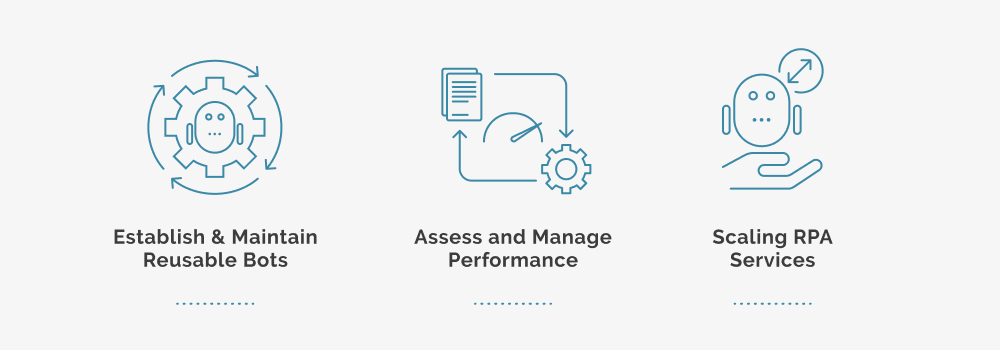
- 1. Establish and maintain reusable bots: A single bot can automate various business processes. A reporting RPA bot, for example, can be utilized for report generation in HR, financial services, and customer service. RPA architects in a CoE can build and implement reusable bots across departments, reducing automation time and cost.
- 2. Assess and manage performance: A robotic process automation center of excellence provides a centralized point for a centralized overview of all RPA bots across the organization, monitoring their performance, detecting bugs and inconsistencies, identifying security breaches, and enforcing organizational policies.
- 3. Scaling RPA services: Various business departments may use various RPA products to digitalize their processes, making scaling across the organization difficult. A centralized RPA development unit guarantees that the organization utilizes the same RPA product, system integration, and plugins, allowing for scalable and robust bot development.
How to Create a Center of Excellence to Implement RPA
Building an RPA center of excellence requires much more than a standard IT team. It necessitates a critical team to support the process from implementation to management and scaling automation company-wide. What you must do is as follows:
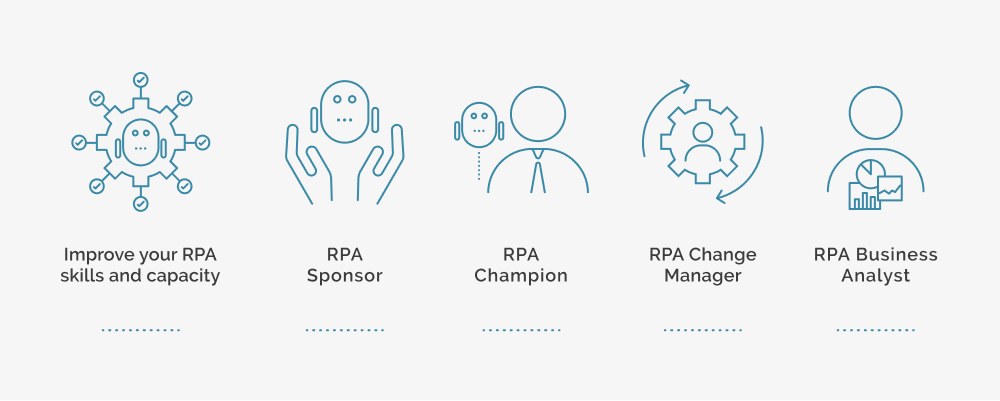
- 1. Improve your RPA skills and capacity: The Robotic Operating Team, which includes a set of defined roles and responsibilities, is at the heart of your CoE. The team is responsible for quickly, efficiently, and safely implementing and managing the automation. The following vital roles are required for a good RPA CoE:
- 2. RPA Sponsor: First, you must define an RPA sponsor. This individual should come from the corporate side and will work to make RPA an enterprise-wide high priority. They’ll be in control of the overall automation strategy.
- 3. RPA Champion: The robotic process automation champion will compel the RPA adoption and implementation process throughout the organization to ensure the development of a healthy automation pipeline. They will be in charge of the digital workforce’s operational management.
- 4. RPA Change Manager: A robotic process automation change manager is critical for ensuring that RPA implementation is simple and scalable within the organization. They are responsible for developing a change and communication strategy that aligns with organizational goals. They would then ensure that every affected stakeholder is informed of the changes and agrees to their implementation.
- 5. RPA Business Analyst: This individual will serve as a process subject matter specialist for business operations. They will be in charge of developing process definitions and automation maps.
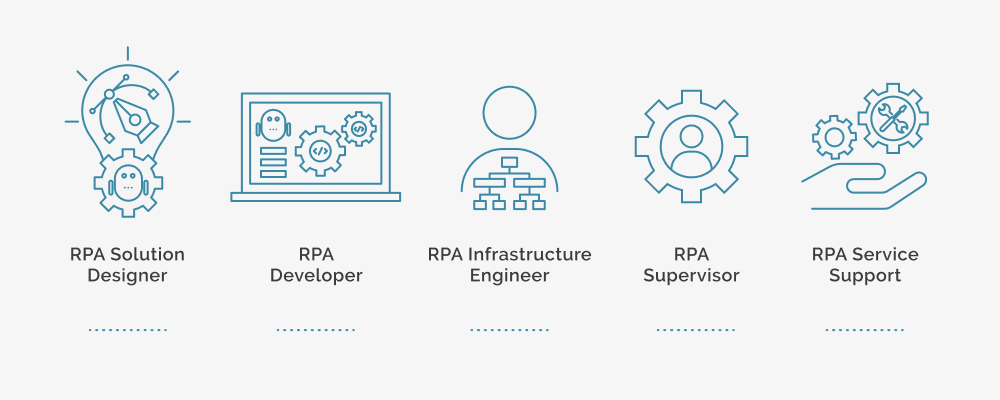
- 6. RPA Solution Designer: This individual is responsible for characterizing the RPA solution’s architecture and overseeing this from start to finish. They will help with the initiative’s development and implementation phases and select the best tools.
- 7. RPA Developer: The Robotic process automation developer is responsible for planning, developing, testing, and supporting the RPA solution’s implementation. They will collaborate with the help of the business analyst to record process details and involve the team in the solution’s performance and testing.
- 8. RPA Infrastructure Engineer: Responsible for infrastructure upgrades for server configuration and troubleshooting. This engineer makes a significant contribution to the project’s solution architecture and is in charge of getting everybody on board during the execution phase.
- 9. RPA Supervisor: As a part of the daily environment, an RPA Supervisor would monitor, orchestrate, and regulate the digital workforce. They are concerned with constantly enhancing the operational effectiveness of the robots and allocating resources through advanced analytics within the automated processes.
- 10. RPA Service Support: During deployment, this role serves as the first point of contact for the RPA solution.
Creating an Efficient Governance Model
A good governance process can go a long way; the sooner it is implemented as part of the automation transformation, the better.
The procedure is in charge of evaluating RPA opportunities and allocating automation tasks. It develops templates and guidelines for evaluation, configuration, development, implementation, demand pipeline, and change management. The governance process is where the protocol for effectively managing change and de-risking operations is established.
This guarantees that actions are taken swiftly, effectively, and equitably throughout the organization. Furthermore, governance entails allocating roles to ensure strong collaboration and communication among business, IT, and compliance teams.
The governance framework outlines the performance and productivity metrics to efficiently conduct evaluations and emphasize business improvement.
Create a Governance Structure to Resolve Cultural Issues and Manage Change.
While business needs typically drive RPA implementation, it is critical to involve IT as early as possible. However, business and IT cultures are fundamentally distinct; CIOs consistently cite business-IT alignment as one of the primary challenges to digital innovation progress.
To overcome cultural differences, Ensure that your governance process is designed to facilitate change, and collaborate with their CoE leaders to:
- Identify a set of accountabilities that includes elements of prioritization and decision-making.
- Integrate the automation strategy with the current governance mechanisms.
- Create a governance board for automation.
- Create a roadmap for enterprise automation.
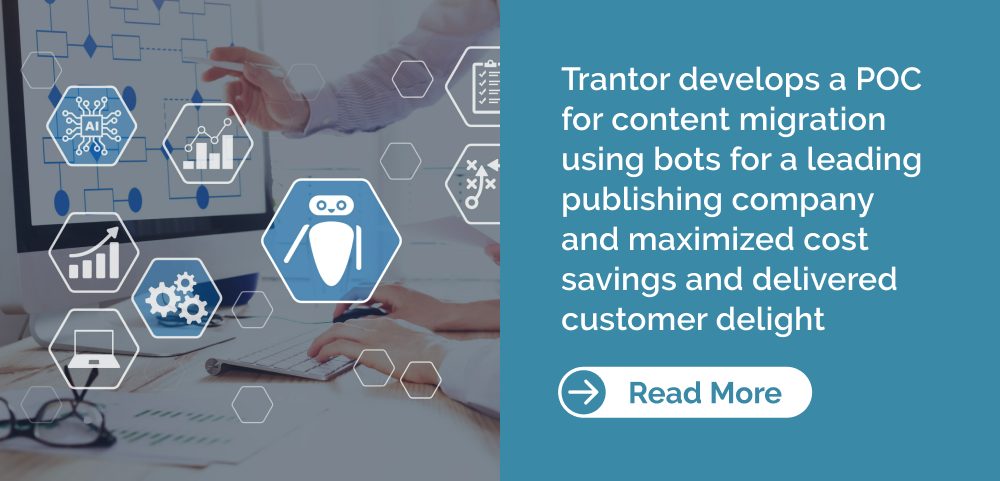
Empower CoE and Plan for Expansion
Many automation initiatives begin with RPA implementation for “quick win” use cases. However, concentrating the CoE on the low-hanging fruits can lead to several issues in the long term, limiting your potential to expand fully across the organization. To place the CoE for long-term success, do the following:
- Begin with one project, but strategize for many more.
- Incorporate learning as you go.
- Manage the complexities of technical debt.
- Expect the CoE’s role & business model to change over time.
- Direct the CoE’s investigation of hyper-automation.
Trantor Captive CoE- Your Perfect Automation Partner
RPA necessitates business knowledge, process expertise, and technical abilities. Many enterprises have very few tech resources available for specific projects or lack the necessary talent to manage an RPA deployment.
At Trantor, we have developed our own Captive Center of Excellence, which drives innovation and excellence throughout our organization.
In addition to extensive expertise in developing and running Captive CoEs, Trantor has a skilled team of RPA engineers, testers, and managers with relevant industry experience to assist you in setting up an RPA CoE.
Our RPA leaders can help you select the appropriate technology and tools to integrate the optimum RPA for your business needs. Contact us today to begin your automation journey!
